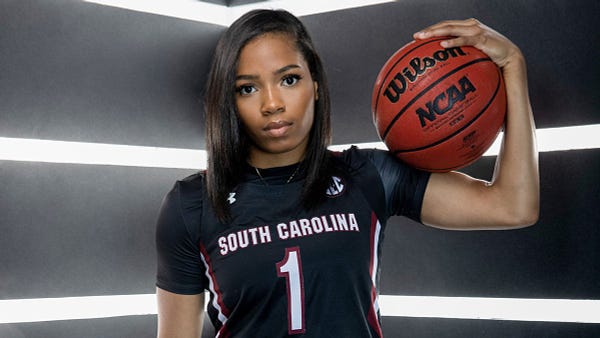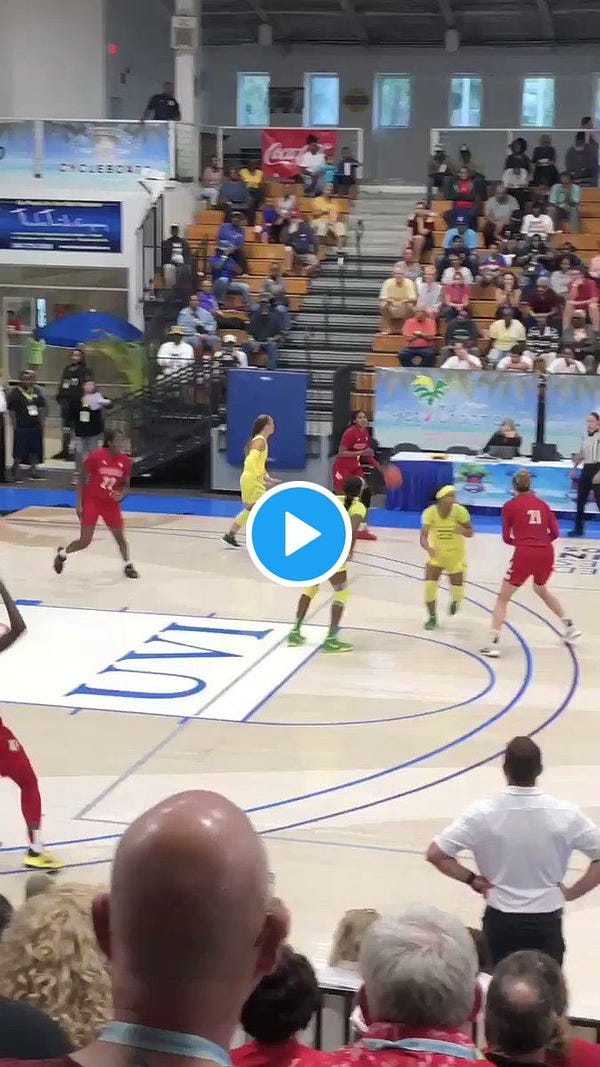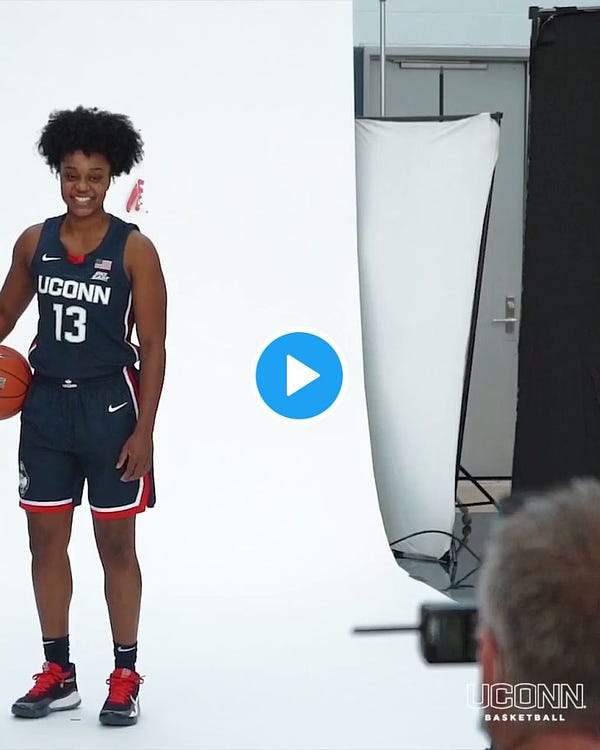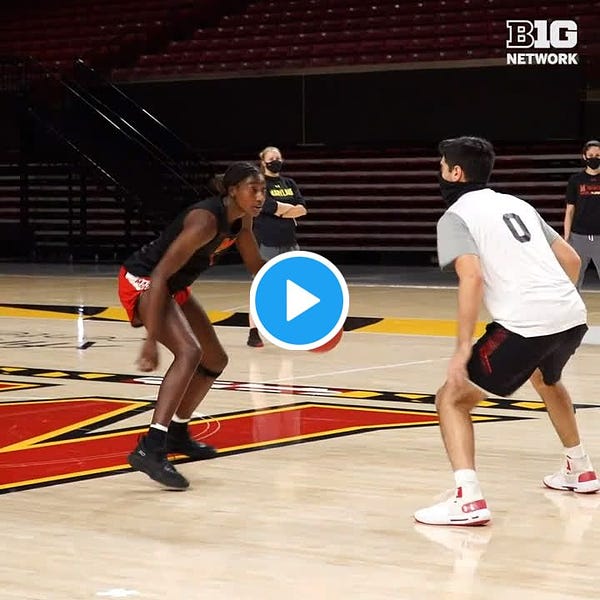Seven Breakout Candidates for the 2020-21 Women’s College Basketball Season
Which players could make big jumps this season?
Thanks for reading the Her Hoop Stats Newsletter. If you like our work, be sure to check out our stats site, our podcast, and our social media accounts on Twitter, Facebook, and Instagram. You can also buy Her Hoop Stats gear, such as laptop stickers, mugs, and shirts!
Haven’t subscribed to the Her Hoop Stats Newsletter yet?
The 2020-21 women’s college basketball season tips off on Wednesday, and it will likely feel at once familiar and unprecedented. Many of us, from school officials to media members to fans, are all too aware that we will need some lucky breaks in order to play a full schedule as COVID-19 cases continue to rise and a vaccine is still months away from mass availability.
In the meantime, the season may be defined by two other kinds of breaks: COVID-19 outbreaks and breakout players. If we can minimize the former, we will have a chance to see a lot of the latter.
Because of the pandemic, players had an unusually long offseason. They often lacked access to a basket or a gym during stay-at-home orders, but many players got creative and were still able to use the downtime to develop their games and incorporate new skills.
Now that the wait is finally over, here are seven players who could be primed for breakout seasons this year:


Zia Cooke, sophomore guard, South Carolina
2019-20 stats: 12.0 points, 2.9 rebounds, and 1.8 assists in 26.5 minutes per game
Because of how much talent is on South Carolina’s roster, you can make a case for nearly any player not named Aliyah Boston to slot in here. (Boston is my preseason pick for National Player of the Year and was a legitimate star as a freshman last season.)
But the Gamecocks’ only other returning double-figure scorer besides Boston is Cooke, who averaged 12 points per game last season while shooting 39% from the field and 35% from behind the arc. She scored at least 20 points four times, but she was inconsistent, scoring five points or fewer in two of her last four games. If she starts at shooting guard again this season, expect her to be more efficient and confident.
However, Cooke could also slide over to point guard to replace graduated senior Tyasha Harris. With a year of experience and learning from Harris under her belt, she would be well-positioned to improve upon her 1.8 assists per game and 1.05 assist-to-turnover ratio last season. And wherever Cooke finds herself on the court, Gamecocks head coach Dawn Staley sees the potential for greatness.
“If the game is on the line, she’s got another gear,” Staley told The Athletic earlier this month. “… She’s just got the ability to shift gears that you only really see in great players.”


Elizabeth Dixon, junior forward, Louisville
2019-20 stats: 4.4 points, 3.6 rebounds, and 0.7 blocks in 14.4 minutes per game
Dixon’s inclusion on this list is equal parts talent and opportunity. The 6-foot-5 forward was named to the All-ACC Freshman team two years ago, when she played for Georgia Tech and averaged 11.0 points and 6.4 rebounds per game. She led the Yellow Jackets in scoring seven times that season and started all 30 games. But she took a back seat when she transferred to Louisville, making four starts and averaging less than five points per game.
This season, Dixon is one of just four forwards on the Louisville roster and the only non-freshman. For Louisville to fulfill its Final Four aspirations, Dixon will likely have to produce like her freshman self on offense and help replace graduated senior Kylee Shook’s defensive presence. That kind of impact on both ends of the court could not only qualify as a breakout season but also put her in contention for another All-ACC team.
Aubrey Griffin, sophomore forward, UConn
2019-20 stats: 6.4 points, 5.4 rebounds, and 1.5 steals in 16.7 minutes per game
In Griffin’s first taste of the UConn-Tennessee rivalry last season, UConn head coach Geno Auriemma said she “was the difference in the game” after she finished with 13 points, seven rebounds, and five steals. For the season, Griffin got a steal on 4.3% of her team’s defensive plays, which ranked in the 99th percentile nationally, and her speed, athleticism, and hustle were apparent whenever she checked into a game. But her minutes fluctuated, eclipsing 30 in two games but also not reaching 10 in seven games, including as late as Feb. 29 against Houston.
Simply put, Griffin was a freshman last year, albeit one of the most talented players in her class. This offseason, she worked out with her brothers, current Syracuse guard Alan and Duke commit A.J., neither of whom took it easy on her. “You can tell,” Auriemma said. “... [She] conducts herself in a way like, ‘I’ve been here.’” That could translate on the stats sheet as Griffin looks to help replace 2020 WNBA Draft pick Megan Walker’s 19.7 points and 8.4 rebounds per game.
Diamond Miller, sophomore guard, Maryland
2019-20 stats: 7.7 points, 3.2 rebounds, and 1.8 assists in 19.1 minutes per game
Before Miller’s senior year of high school, she made SportsCenter’s “Top Ten Plays” for a crossover move that sent her defender falling to the ground. Between that driving ability and her frequent size advantage as a 6-foot-3 guard, Miller was a tough assignment for nearly any defender as a freshman last season. She scored at least 15 points four times, had 10 points on 4-for-4 shooting against George Washington, and nearly recorded her first collegiate double-double with nine points and eight rebounds against Georgia State. But she was also relatively foul-prone (her 4.9% foul rate ranked in just the 32nd percentile nationally) and had room to increase her offensive efficiency.
Maryland head coach Brenda Frese recently raved about Miller’s improvement, over and above the typical leap that players make from their freshman to sophomore seasons. “She is at a whole different level of wanting to make huge plays,” Frese told Locked On WBB’s Howard Megdal. “She’s so much stronger, her three[-pointer]s are even deeper, she’s able to get to the rim and finish with contact. She’s just playing at an All-American level, which has been really impressive to see.”


Charisma Osborne, sophomore guard, UCLA
2019-20 stats: 12.2 points, 5.8 rebounds, and 1.5 steals in 29.4 minutes per game
It’s hard to tell exactly how good UCLA will be this season because two opt-outs, injuries, and difficulties getting international players into the country have left the Bruins with just seven to eight players practicing on a given day.
What is more obvious is that the Bruins will rely heavily on sophomore Charisma Osborne, a combo guard who attended the same high school as former UCLA and current Seattle Storm point guard Jordin Canada. As a freshman, Osborne already filled a critical role for UCLA: she was the team’s third-leading scorer at 12.2 points per game, shot a team-high 33% from 3-point range, and played lockdown defense. But this season, with the graduation of second-leading scorer Japreece Dean, Osborne could take on an even bigger role as the Robin to preseason All-American Michaela Onyenwere’s Batman.
Sedona Prince, redshirt sophomore forward, Oregon
Has not made her NCAA debut yet; averaged 22.3 points, 8.2 rebounds, and 4.7 blocks per game as a high school senior
Prince was the No. 8 player coming out of high school and scored over 2,700 points in 154 high school games. But just before her freshman season at Texas, the 6-foot-7 Prince broke her leg playing with Team USA. She suffered complications from that injury and transferred to Oregon after one year because she felt “very unsafe” and “neglected” by the Texas medical staff during her recovery. Prince sat out last season due to NCAA transfer rules and is finally healthy and eligible for the Ducks.
It’s perfect timing for Oregon, which lost star post player Ruthy Hebard to the WNBA and needs a new anchor inside. Head coach Kelly Graves has indicated that the offense will run through Prince this season, and that won’t just mean scoring in the paint. Prince can shoot 3-pointers, and Graves indicated that she is also an excellent passer. That passing ability could free up the Ducks’ guards, four of whom shot better than 40% from behind the arc last season, and create even more space for Prince to go to work herself.


Hannah Sjerven, senior center, South Dakota
2019-20 stats: 12.3 points, 7.5 rebounds, and 2.0 blocks in 20.1 minutes per game
Sjerven has already had her breakout in the Summit League, as she was the conference’s Transfer and Sixth Woman of the Year in 2018-19 and its Defensive Player of the Year in 2019-20. She has been remarkably productive for the Coyotes despite averaging just 18 and 20 minutes per game in her two seasons: her total rebounding rate (21.9%) and block rate (11.5%) each ranked 11th nationally last season, and her 1.22 points per scoring attempt also ranked within the top 100.
Sjerven was in foul trouble at times last year, but she also didn’t need to play major minutes because South Dakota had six other players who appeared in all 31 games and averaged at least 16 minutes. However, three of those six players graduated last year (including our 2020 Becky Hammon Mid-Major Player of the Year, Ciara Duffy), so Sjerven may be asked to play more minutes this season. If she can sustain her productivity in those additional minutes and limit her fouls, she could break out on a national stage and perhaps even garner some WNBA Draft attention.
All statistics are from Her Hoop Stats unless otherwise noted.
Thanks for reading the Her Hoop Stats Newsletter. If you like our work, be sure to check out our stats site, our podcast, and our social media accounts on Twitter, Facebook, and Instagram.










Gonna nail biter of a draft!